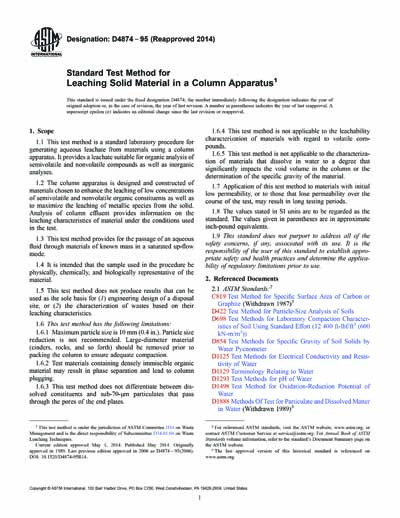Historical
ASTM D4874-95(2014)
Standard Test Method for Leaching Solid Material in a Column Apparatus
1.1 This test method is a standard laboratory procedure for generating aqueous leachate from materials using a column apparatus. It provides a leachate suitable for organic analysis of semivolatile and nonvolatile compounds as well as inorganic analyses.
1.2 The column apparatus is designed and constructed of materials chosen to enhance the leaching of low concentrations of semivolatile and nonvolatile organic constituents as well as to maximize the leaching of metallic species from the solid. Analysis of column effluent provides information on the leaching characteristics of material under the conditions used in the test.
1.3 This test method provides for the passage of an aqueous fluid through materials of known mass in a saturated up-flow mode.
1.4 It is intended that the sample used in the procedure be physically, chemically, and biologically representative of the material.
1.5 This test method does not produce results that can be used as the sole basis for (1) engineering design of a disposal site, or (2) the characterization of wastes based on their leaching characteristics.
1.6 This test method has the following limitations:
1.7 Application of this test method to materials with initial low permeability, or to those that lose permeability over the course of the test, may result in long testing periods.
1.8 The values stated in SI units are to be regarded as the standard. The values given in parentheses are in approximate inch-pound equivalents.
1.9 This standard does not purport to address all of the safety concerns, if any, associated with its use. It is the responsibility of the user of this standard to establish appropriate safety and health practices and determine the applicability of regulatory limitations prior to use.
ASTM International [astm]

